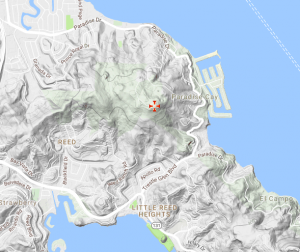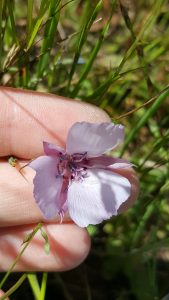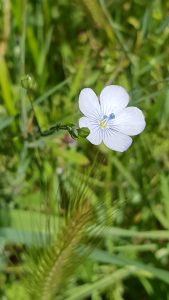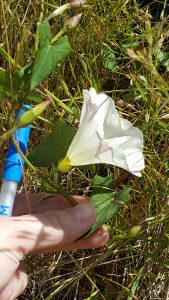Ring Mountain: 37.90974, -122.48580

Ring Mountain is an area at the north end of the Tiburon Peninsula in Marin County. It has serpentine rock outcrops and also includes rare and endangered flora (such as the Tiburon mariposa lily). Ring Mountain is only 602 feet tall, but one can enjoy views of Mt. Tamalpais, the North Bay hills and the San Francisco skyline. It was dominated by vegetative shrubs less than 5 meters tall. There were many, many grass species and a diverse range of flowering plants.
Based on these characteristics, I would classify this floral community as grassland or prairie. This area is able to support a wide array of wildlife.
Calochortus umbellatus (Oakland mariposa lily)

C. umbellatus is a perennial herb that is both native and endemic to California. It is a member of the family Liliaceae. Its stems tend to be 8 to 25 centimeters long, and its leaves are persistent, carline, and generally linear. The inflorescences are more or less umbel-like and erect, with 3 to 12 flowers per inflorescence. The flowers themselves are perianth bell-shaped and tend to be white or pale pink to lilac with purples spots at the base. Its sepals and petals are distinct from each other. The petals are 12 to 18 millimeters long and are widely wedge shaped to obovate. In addition, the petals are glabrous. The filaments are about 5 millimeters long, and the anthers are about 2 millimeters long and light blue or pink. When fruit is present it is 10 to 14 millimeters wide and elliptic or winged. The seeds are irregular, dark brown, and netlike It often grows on serpentine soils, and is found in open chaparral or woodland. This particular specimen was found on the edge of a moist trail in full sunlight.
Linum bienne (Flax)
L. bienne is a non-native, annual herb in the family Linaceae. It tends to grow from 6 to 60 centimeters tall, with glabrous stems. Its leaves are 5 to 25 millimeters long and tend to be linear. The flowers have distinct sepals and petals. The sepals are about 5 millimeters long, and are ovate to lanceolate with translucent margins. The petals are light blue and 6 to 10 millimeters long. They also have free styles and linear to club-shaped stigmas. When fruit is present, it is 4 to 6 millimeters wide and dehiscent. The seeds are about 3 millimeters wide and dark brown to black. Flax is often found in grassland, woodland, and disturbed places. This particular specimen was also found on the side of a moist trail in full sunlight.
Calystegia purpurata (Smooth Western morning glory)
C. purpurata is a perennial herb that is both native and endemic to California. It is a member of the family Convolvulaceae. It is glabrous, with a trailing to strongly climbing stem less than 7 meters long. Its leaves are 1.5 to 5 centimeters long and are triangular to reniform. It exhibits peduncle inflorescence and its bracts do not hide the calyx. Its flowers are made up of sepals 7 to 14 millimeters wide and a corolla 23 to 52 millimeters wide. They are white/cream to purple, and often have purple stripes. This species also has two subspecies: subspecies purpurata and subspecies saxicola. This specimen most closely resembles subspecies purpurata because its leaves are triangular and V-shaped. Their lobes are also strongly angled and the margins are not wavy. This species, in general, is found in chaparral and coastal scrub. This particular specimen was found on the side of a moist trail in full sunlight.
Views on a beautiful day…







